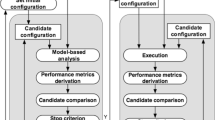Abstract
The HPC community has been using abstract, representative applications and architecture models to enable faster co-design cycles. While developers often qualitatively verify the correlation of the application abstractions to the parent application, it is equally important to quantify this correlation to understand how the co-design results translate to the parent application. In this paper, we propose a multi-fidelity surrogate (MFS) approach which combines data samples of low-fidelity (LF) models (representative apps and architecture simulation) with a few samples of a high-fidelity (HF) model (parent app). The application of MFS is demonstrated using a multi-physics simulation application and its proxy-app, skeleton-app, and simulation models. Our results show that RMSE between predictions of MFS and the baseline HF models was 4%, which is significantly better than using either LF or HF data alone, demonstrating that MFS is a promising approach for predicting the parent application performance while staying within a computational budget.
Access this chapter
Tax calculation will be finalised at checkout
Purchases are for personal use only
Similar content being viewed by others
References
Center for Compressible Multiphase Turbulence webpage, 15 February 2015. https://www.eng.ufl.edu/ccmt/
NEK5000 webpage. https://nek5000.mcs.anl.gov/
Vulcan Supercomputer, LLNL webpage. https://computation.llnl.gov/computers/vulcan
Balabanov, V., Grossman, B., Watson, L., Mason, W., Haftka, R.: Multifidelity response surface model for HSCT wing bending material weight. In: 7th AIAA/USAF/NASA/ISSMO Symposium on Multidisciplinary Analysis and Optimization, p. 4804 (1998)
Banerjee, T., Hackl, J., Shringarpure, M., Islam, T., Balachandar, S., Jackson, T., Ranka, S.: CMT-bone: a proxy application for compressible multiphase turbulent flows. In: 2016 IEEE 23rd International Conference on High Performance Computing (HiPC), pp. 173–182, December 2016
Barrett, R.F., Borkar, S., Dosanjh, S.S., Hammond, S.D., Heroux, M.A., Hu, X.S., Luitjens, J., Parker, S.G., Shalf, J., Tang, L.: On the role of co-design in high performance computing (2013)
Barrett, R.F., Vaughan, C.T., Heroux, M.A.: Minighost: a miniapp for exploring boundary exchange strategies using stencil computations in scientific parallel computing. Sandia National Laboratories, Technical report SAND 5294832 (2011)
Box, G.E.P., Hunter, J.S., Hunter, W.G.: Statistics for Experimenters: Design, Innovation, and Discovery, vol. 2. Wiley-Interscience, New York (2005)
Dosanjh, S.S., Barrett, R.F., Doerfler, D., Hammond, S.D., Hemmert, K.S., Heroux, M.A., Lin, P.T., Pedretti, K.T., Rodrigues, A.F., Trucano, T.: Exascale design space exploration and co-design. Future Gener. Comput. Syst. 30, 46–58 (2014)
Dosanjh, S.S., Barrett, R.F., Doerfler, D., Hammond, S.D., Hemmert, K.S., Heroux, M.A., Lin, P.T., Pedretti, K.T., Rodrigues, A.F., Trucano, T., et al.: Assessing the role of mini-applications in predicting key performance characteristics of scientific and engineering applications. J. Parallel Distrib. Comput. 30, 107–122 (2014)
Ellis, M., Mathews, E.: A new simplified thermal design tool for architects. Build. Environ. 36, 1009–1021 (2011)
Fernández-Godino, M.G., Park, C., Kim, N.H., Haftka, R.T.: Review of multi-fidelity models. arXiv preprint arXiv:1609.07196 (2016)
Heroux, M.A., Doerfler, D.W., Crozier, P.S., Willenbring, J.M., Edwards, H.C., Williams, A., Rajan, M., Keiter, E.R., Thornquist, H.K., Numrich, R.W.: Improving performance via mini-applications. Sandia National Laboratories, Technical report SAND2009-5574 3 (2009)
Huang, D., Allen, T., Notz, W., Miller, R.: Sequential kriging optimization using multiple-fidelity evaluations. Struct. Multi. Optim. 32, 369–382 (2006)
Jin, R., Chen, W., Sudjianto, A.: An efficient algorithm for constructing optimal design of computer experiments. J. Stat. Plan. Infer. 134, 268–287 (2005)
Karlin, I., Keasler, J., Neely, R.: Lulesh 2.0 updates and changes. Technical report LLNL-TR-641973 (2013)
Kennedy, M.C., O’Hagan, A.: Bayesian calibration of computer models. J. Roy. Stat. Soc. Ser. B (Stat. Methodol.) 63(3), 425–464 (2001)
Kumar, N., Sringarpure, M., Banerjee, T., Hackl, J., Balachandar, S., Lam, H., George, A., Ranka, S.: CMT-bone: a mini-app for compressible multiphase turbulence simulation software. In: 2015 IEEE International Conference on Cluster Computing, pp. 785–792, September 2015
Kumar, N., Pascoe, C., Hajas, C., Lam, H., Stitt, G., George, A.: Behavioral emulation for scalable design-space exploration of algorithms and architectures. In: Taufer, M., Mohr, B., Kunkel, J.M. (eds.) ISC High Performance 2016. LNCS, vol. 9945, pp. 5–17. Springer, Cham (2016). https://doi.org/10.1007/978-3-319-46079-6_1
Le Gratiet, L.: Multi-fidelity Gaussian process regression for computer experiments. Universit Paris-Diderot-Paris VII (2013)
Peherstorfer, B., Willcox, K., Gunzburger, M.: Survey of multifidelity methods in uncertainty propagation, inference, and optimization (2016)
Qian, P.Z., Wu, C.J.: Bayesian hierarchical modeling for integrating low-accuracy and high-accuracy experiments. Technometrics 50, 192–204 (2008)
Xiong, Y., Chen, W., Tsui, K.L.: A new variable-fidelity optimization framework based on model fusion and objective-oriented sequential sampling. J. Mech. Des. 130(11), 111401 (2008)
Zhang, Y., Kim, N.H., Park, C., Haftka, R.T.: Multi-fidelity surrogate based on single linear regression. ArXiv e-prints arXiv:1705.02956 (2017)
Zhang, Y., Meeker, J., Schutte, J., Kim, N., Haftka, R.: On approaches to combine experimental strength and simulation with application to open-hole-tension configuration. In: Proceedings of the American Society for Composites: Thirty-First Technical Conference (2016)
Zheng, L., Hendrick, T.L., Mittal, R.: A multi-fidelity modelling approach for evaluation and optimization of wing stroke aerodynamics in flapping flight. J. Fluid Mech. 721, 118–154 (2013)
Acknowledgment
This work is supported by the U.S. Department of Energy, National Nuclear Security Administration, Advanced Simulation and Computing Program, as a Cooperative Agreement under the Predictive Science Academic Alliance Program, under Contract No. DE-NA0002378.
Author information
Authors and Affiliations
Corresponding author
Editor information
Editors and Affiliations
Rights and permissions
Copyright information
© 2018 Springer International Publishing AG
About this paper
Cite this paper
Zhang, Y. et al. (2018). Multi-fidelity Surrogate Modeling for Application/Architecture Co-design. In: Jarvis, S., Wright, S., Hammond, S. (eds) High Performance Computing Systems. Performance Modeling, Benchmarking, and Simulation. PMBS 2017. Lecture Notes in Computer Science(), vol 10724. Springer, Cham. https://doi.org/10.1007/978-3-319-72971-8_9
Download citation
DOI: https://doi.org/10.1007/978-3-319-72971-8_9
Published:
Publisher Name: Springer, Cham
Print ISBN: 978-3-319-72970-1
Online ISBN: 978-3-319-72971-8
eBook Packages: Computer ScienceComputer Science (R0)




